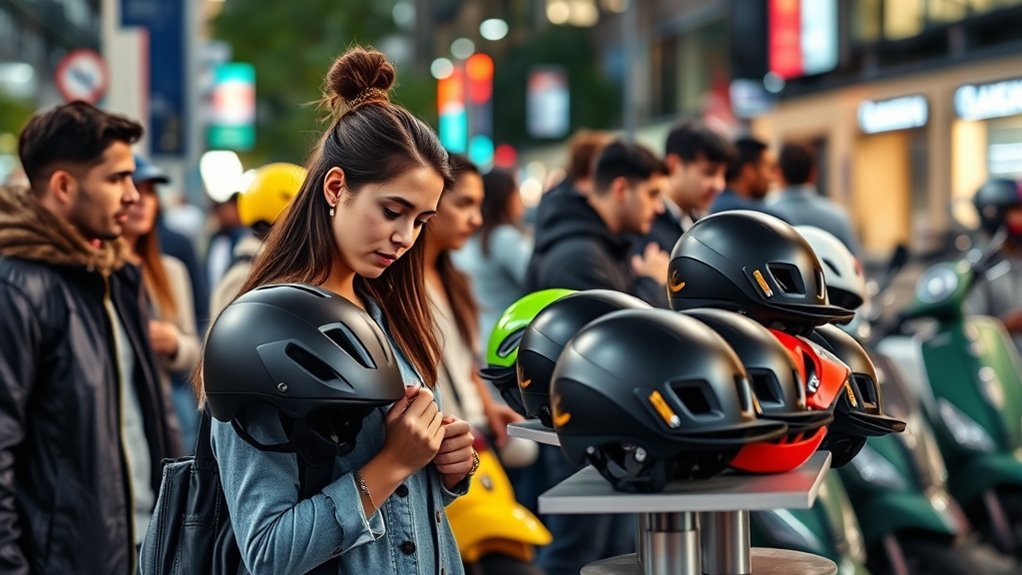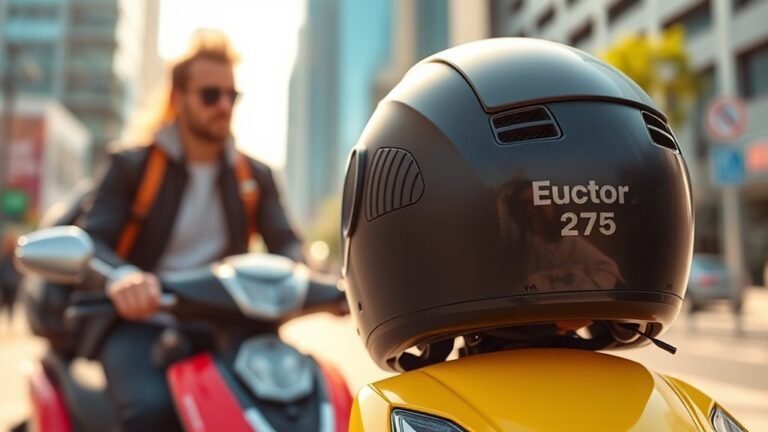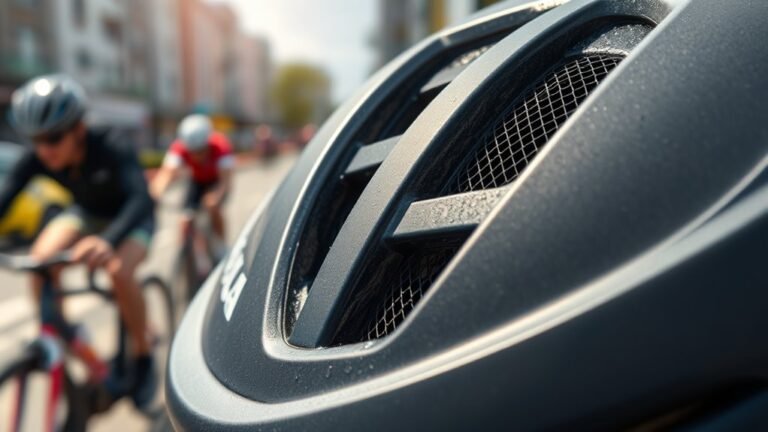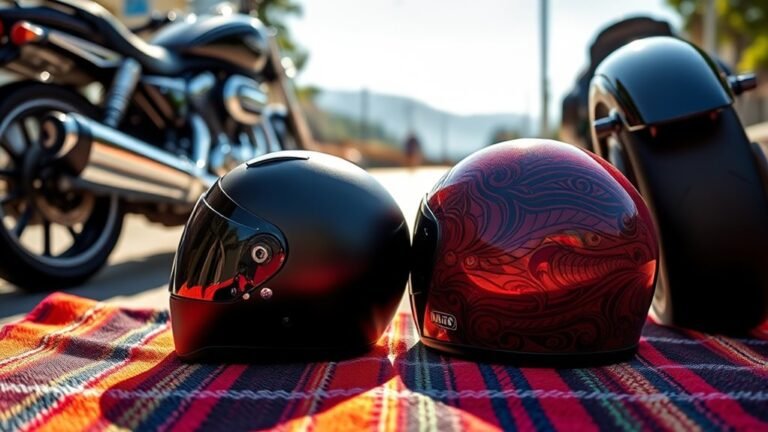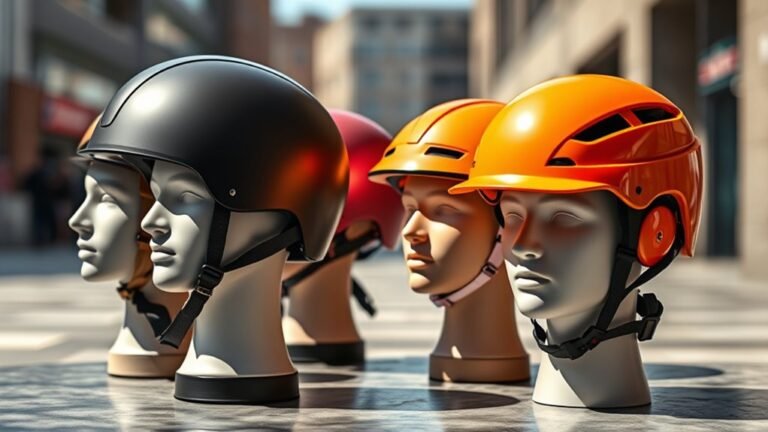How to Choose a Helmet for Shared Scooter Riding
When choosing a helmet for shared scooter riding, prioritize safety and comfort. Look for a helmet that offers impact resistance, good ventilation, and a proper fit. Consider a full face helmet for maximum protection or an open face helmet for better airflow, depending on your riding style. Make sure the helmet is snug yet comfortable, and check for quality materials. Regular maintenance is essential for ensuring your helmet stays in great shape. There’s more to learn about helmet features and care techniques.
Importance of Helmet Safety

When you’re cruising around on your scooter, wearing a helmet isn’t just a good idea—it’s essential for your safety. Helmet regulations vary by region, but they all share a common goal: to protect your head in case of an accident. A quality helmet provides vital brain protection, greatly reducing the risk of serious injuries. Without it, you’re leaving yourself vulnerable, and the thrill of freedom quickly turns into a dangerous gamble. It’s important to choose a helmet that meets safety standards, ensuring it’s built to withstand impacts. Remember, the right helmet not only enhances your riding experience but also gives you peace of mind, allowing you to enjoy the open road without unnecessary worry. So gear up and ride safe!
Types of Helmets for Scooter Riding

Choosing the right helmet for scooter riding can make all the difference in your safety and comfort. There are mainly two types of helmets to evaluate: full face helmets and open face helmets.
| Helmet Type | Key Features |
|---|---|
| Full Face Helmet | Offers complete head protection, ideal for high-speed rides. |
| Open Face Helmet | Provides more ventilation and visibility, great for city commuting. |
Full face helmets are perfect for those who prioritize maximum safety, while open face helmets cater to riders seeking freedom and airflow. Each type has its pros and cons, so reflect on your riding style and environment. Choosing the right helmet can enhance your riding experience while keeping you safe.
Key Features to Look For
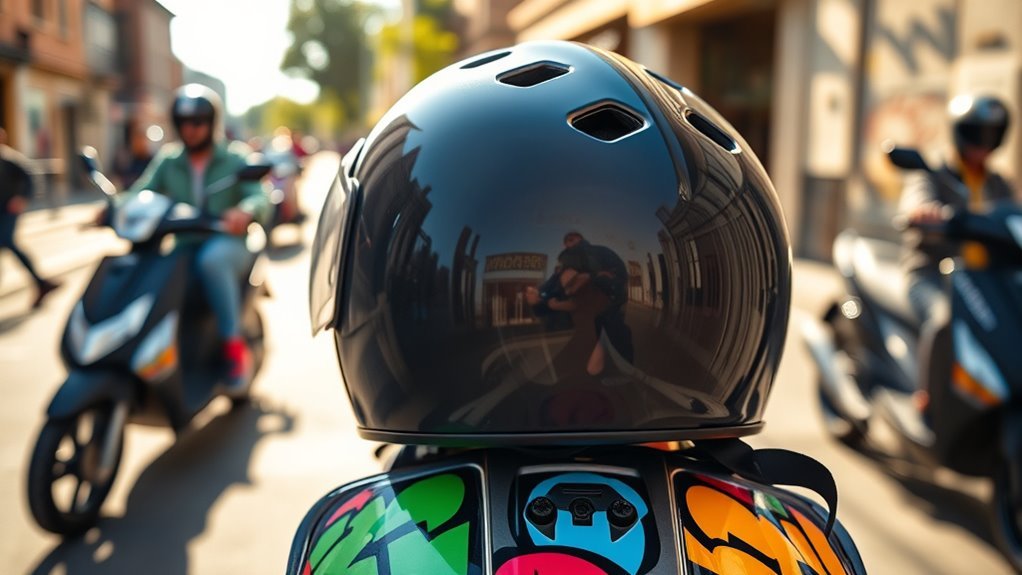
While selecting a helmet for scooter riding, it’s essential to evaluate several key features that can greatly impact your safety and comfort. You’ll want to take into account the following design considerations and material types to guarantee you make a smart choice:
Choosing the right helmet for scooter riding is crucial for ensuring your safety and comfort on the road.
- Impact Resistance: Look for helmets made with high-quality materials that provide excellent shock absorption.
- Ventilation: A well-ventilated design helps keep you cool during rides, enhancing your comfort.
- Weight: Opt for a lightweight helmet to avoid neck strain, especially during longer rides.
- Visibility: Choose a helmet with reflective elements or bright colors to enhance your visibility to others.
Ensuring a Proper Fit
How can you guarantee your helmet fits properly? First, measure your head size using a soft measuring tape, wrapping it just above your eyebrows and around the back of your head. This measurement helps you choose the right size among various helmet styles. Most helmets come with size charts, so refer to those to ascertain an accurate fit. When trying on a helmet, it should sit level on your head, snug but not overly tight, and shouldn’t shift when you shake your head. The chin strap should be securely fastened, allowing you to fit one or two fingers between your chin and the strap. A proper fit not only enhances comfort but also maximizes safety while you enjoy the freedom of scooter riding.
Maintenance and Care for Your Helmet
Once you’ve found a helmet that fits properly, maintaining it is key to guaranteeing its longevity and effectiveness. Regular care not only keeps your helmet looking great but also guarantees it performs well when you need it most. Here are some essential maintenance tips:
- Use gentle cleaning techniques: Wipe down the exterior with a damp cloth and mild soap to remove dirt and grime.
- Check for damage: Regularly inspect for cracks or dents that might compromise safety.
- Store it properly: Keep your helmet in a cool, dry place away from direct sunlight to prevent material degradation.
- Avoid extreme temperatures: Don’t leave it in hot cars or cold garages; temperature extremes can weaken your helmet.
With proper maintenance, your helmet will be ready for every ride!
Frequently Asked Questions
Can I Use a Bike Helmet for Scooter Riding?
Yes, you can use a bike helmet for scooter riding, as long as it meets helmet standards for safety. Both activities involve similar speeds and risks, so a properly fitted bike helmet can provide adequate protection. However, make sure it’s in good condition and hasn’t been damaged. Prioritizing scooter safety means choosing a helmet that covers your head well, ensuring you enjoy your ride with confidence and freedom while staying protected.
How Often Should I Replace My Helmet?
You should replace your helmet every 3 to 5 years, but hey, if you think your helmet’s got a longer lifespan than a cockroach, think again! Safety standards are there for a reason. Regularly inspect for any cracks or damage, too. If you’ve taken a hard fall, it’s time to bid farewell to your trusty headgear. Remember, a helmet’s just a piece of plastic without your noggin’ safely underneath it!
Are There Specific Helmets for Electric Scooters?
Yes, there are specific helmets designed for electric scooters. Look for helmets that meet safety standards like CPSC or ASTM to guarantee protection. When choosing, consider helmet materials such as polycarbonate or fiberglass for durability and weight. Some helmets even come with additional features like visors or built-in lights for increased visibility. Prioritizing safety doesn’t mean sacrificing comfort or style, so find one that fits well and complements your freedom-loving spirit.
What Size Helmet Do I Need for Shared Scooters?
To find the right size helmet for shared scooters, measure the circumference of your head just above your eyebrows. Use a sizing chart from the manufacturer, as sizes can vary. A proper fit means the helmet should sit snugly without wobbling or pinching. You should be able to fit one or two fingers between your chin and the strap. Remember, a well-fitted helmet is essential for your safety and freedom on the road!
Can I Decorate or Customize My Helmet?
Absolutely, you can customize your helmet! In fact, studies show that personalized helmets can increase wear rates by 30%. For helmet safety, use removable decals or paint designed for plastic. Avoid covering vents or safety certifications. Consider adding reflective tape for visibility or attaching unique accessories that won’t compromise the helmet’s integrity. Just remember, while you express your style, maintaining safety should always be your top priority. Enjoy the ride!
